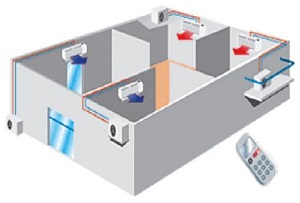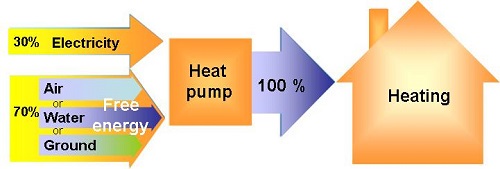When
capable of operating in air conditioning and heating mode, the
air conditioner is called reversible.
In
winter, we can say it operates in hot
mode.
Note:
We
can also say that the air conditioner is operating in « heat
pump » mode, but from a fiscal angle, a basic reversible air
conditioner is not considered as a real heat pump (except under
certain conditions).
This
takes nothing away from the benefit of choosing a reversible air
conditioner when air-con is necessary.
The switchover of reversible air conditioners from “cold” mode to “hot” mode and vice-versa is carried out by a cycle reversal valve (see course « Presentation of refrigerating machines ») which can be piloted by a dual function (combination) ambient thermostat.

Reversal of refrigerating cycle by action of the cycle reversal valve
Question
How many air conditioners are installed in the building below?
How many units operate in “cold” mode (air conditioning), and how many in “hot” mode?
Why should some rooms of the same building be heated while others are cooled?

The house is fitted with 4 air conditioners. Two units operate in cold mode, and 2 in hot mode.
This situation can occur in buildings in “mid-season” when a non-sunlit façade has heat losses while a sunlit façade must start to be cooled.
It can also occur in buildings of the tertiary sector when certain spaces are subject to interior generated heat such as computers, meetings etc., and not the others.
All the benefit of heat pumps lies in the fact that to supply 10 [kWh] (34,121 btu) of heat, energy consumption, generally electric, is only approx. 3 [kWh] (10,236 btu).
Due to this, if the heat pump is capable of replacing an all-electric heating system, the bill will be divided by 3.
Question
While admitting that gas or oil fired heating is 2 times less costly than all-electric heating, express in percentage terms the economy achieved when a HP completely replaces a gas or oil system.
– 33 %
Explanation:
Let’s consider all-electric heating as “the reference” at 100%.
Oil or gas heating is 2 times less costly, so 50% of the “all-electric” cost.
Integral heating by HP will be 3 times less costly, so 33% of the “all-electric” cost.
If we compare integral heating by HP (which costs only 33% of all-electric costs) to gas or oil heating (which costs only 50% of all-electric costs), the ratio is:
33/50 = 0.66
This means that the cost of integral heating by HP is 66% of that of oil or gas (so 33% less costly).
Heating by HP is an excellent use of electricity, more useful for turning motors than being directly used for all-electric heating….(see dossier of applied physics “Energy & Heat”).

